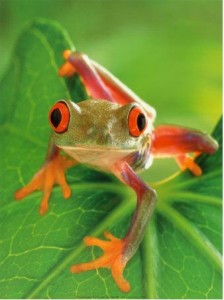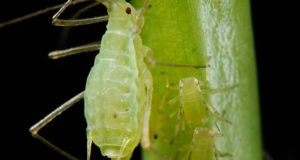No matter where you live, some types of frogs and toads are native. These amphibians live throughout the world, but unfortunately, they are on the decline. Various environmental threats are causing them to become fewer in number, and worried environmentalists and biologists consider them to be a sort of canary in the coal mine. Reasons such as pollution, pesticides, and loss of habitat have been cited as causes for the drop in toad and frog populations throughout the world.
What Are Frogs And Toads?
 Frogs and toads are two types of amphibians. Amphibians are a classification of animals distinct from mammals, reptiles, birds, fish, and insects. They are characterized by the fact that they live part of their lives in water and part on land. Most, although not all, amphibians lay their eggs in water, which develop into tadpoles. Tadpoles are very similar to fish and eventually develop into frogs, toads, newts, or salamanders.
Frogs and toads are two types of amphibians. Amphibians are a classification of animals distinct from mammals, reptiles, birds, fish, and insects. They are characterized by the fact that they live part of their lives in water and part on land. Most, although not all, amphibians lay their eggs in water, which develop into tadpoles. Tadpoles are very similar to fish and eventually develop into frogs, toads, newts, or salamanders.
Most people mix up frogs and toads and fail to understand the distinction between the two. The truth is that toads are in fact frogs, but there are also true frogs, which are not considered to be toads. The so called true frogs belong to a family called Ranidae and have bulging eyes, smooth and slimy skin, and strong, webbed hind feet for swimming and jumping. They also lay their eggs in clusters and prefer to be in very moist environments.
Toads, on the other hand, belong to the Bufonidae family and have shorter hind legs for walking, bumpy, dry skin, and poison glands behind their eyes. They prefer dryer environments and lay their eggs in long chains. There are about 400 different true frog species and around 300 toad species.
New Survival Seed Bank™ Lets You Plant A Full Acre Crisis Garden!
What Is Causing The Decline In Frogs And Toads?
The exact reasons for a decline in frog and toad populations is not completely understood, but it is well documented. More amphibian species are threatened than any other type of animal. According to the International Union for the Conservation of Nature, at least 41 percent of amphibian species are at risk of extinction. That is far more than any other kind of animal.
Some of the reasons that may account for declining frogs and toads include loss of habitat. This is a common issue for many species of animals, but amphibians seem to be especially affected. Urban sprawl in many areas is quickly destroying habitat. While squirrels and raccoons can still live in suburban trees, frogs and toads need the ponds and wetlands that are being destroyed by suburban expansion.
Pollution and pesticide use may also be a reason. Frogs and toads eat insects, and when we spray pesticides on our lawns to control for insects that we find to be a nuisance, the amphibians suffer. Pollution of waterways can also affect them, as they lay their eggs in water.
Why Should We Be Concerned For Them?
Besides the fact that they are fun to watch and find on nature walks and that they are awfully cute, frogs and toads disappearing are a great concern for many other reasons. They are an important part of ecosystems. They are also a big part of their ecosystems. In some areas, frogs and toads are more prevalent than any other type of animal. They also indicate the overall health of the environment. They are more sensitive to changes than many other species and give us an early warning of pollution and climate change.
Many medicines, including antibiotics, analgesics, and HIV medications, have come from the skin of amphibians. They could still hold a wealth of important cures and treatments for many human illnesses. In our own backyards, frogs and toads work hard to keep the insect population down. When you have a healthy population, you need not worry about mosquitoes, flies, and other pests.
How Can You Help Amphibians?
There are many ways in which you can help amphibians by simply encouraging them to thrive on your property. Sometimes the best work you can do for the environment and endangered species is right in your backyard.
- Keep natural areas. A perfectly manicured and bug-free lawn may look nice, but it does not create a good environment for toads and frogs, or for any type of animal really. Consider keeping much of your property in a natural state. Not only will you encourage your toad and frog populations, but you will help all of the species of animals that are native to your local ecosystem. If you have a lot of property, you can garden and manicure a portion of it and let the rest stay natural.
- Don’t use pesticides. Pesticides are killers for insects and amphibians. Insects are a major part of the diet of toads and frogs, and when you kill them, you kill the amphibians. The pesticides make the frogs and toads sick, weak, and even kill them if they eat enough contaminated insects. If you support not just frogs and toads, but also native birds, bats, and other animals, you won’t want to use any pesticides.
- Have water sources available. Frogs and toads, like all amphibians, need a good water supply to survive and to thrive. They lay their eggs in water, and if you have a pond, you will give your local amphibians a great place to start the next generation. If you have a natural pond or wetland area on your property, you’re in luck. If not, you can create a pond for your amphibious friends. Make sure it has both deep and shallow areas, low edges, native plants around the edge, and a couple of logs or rocks in the water. Avoid a fountain feature, as they don’t like running water.
- Put out a toad light. If you put a small light by the pond, or a little ways away from it, you will be able to create a cloud of insects from which your toads and frogs can feed. Even if you don’t have a pond close to your house, put out a toad light and see if you can attract any. Chances are you will get a show.
- Provide protection from predators. To survive in any environment, toads and frogs need protection from predators. They are vulnerable to being eaten by large birds, foxes, and even raccoons. A lot of vegetation around a pond is helpful, but you can also create a little toad home for your new friends. This can be as simple as an overturned flowerpot, tilted up slightly by resting the rim on a rock. A pile of rocks with frog and toad-sized crevices will also work. You can even buy toad houses specially made for placing in the backyard.
- Be a citizen scientist. This is a great way to get involved with helping save amphibians. Biologists who study them often need help from people like you to survey frog and toad populations. FrogWatch USA, for instance, is a group run by the Association of Zoos and Aquariums. They ask volunteers to help record and count frog and toad calls heard in their local environment. You can join up with this group or find another, as there are many. This could be a fun project to do with the kids!
©2012 Off the Grid News
 Off The Grid News Better Ideas For Off The Grid Living
Off The Grid News Better Ideas For Off The Grid Living




